North America is filled with many wonderful birds with blue wings – in fact, there are 13 birds that you can spot with blue wings. Have you spotted a bird with blue wings that you’re looking to identify? Look no further than this article.
This list will list all 13 birds and help birdwatchers find and identify all birds of North America that have blue wings with both pictures and calls.
1. White-breasted Nuthatch
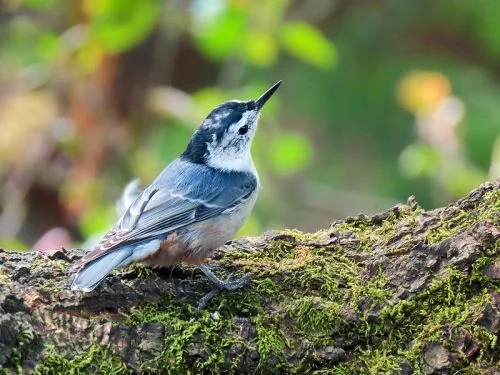
The white-breasted nuthatch is a species of bird in the nuthatch family Sittidae. Its length is about 15.5 cm, making it a medium-sized nuthatch. The White-breasted Nuthatch tends to thrive in a variety of environments, including forests, park-like settings, and even suburbs, as long as old trees are present, much like the versatile Blue Jay and American Robin. Even though this bird is still common, it faces the same dangers as less adaptable species, like being eaten by cats or running into glass.
They consume primarily insects (and spiders) throughout the summer and seeds in the winter. From zero in the summer to more than 60% in the winter, the percentage of seeds in the diet might change. will consume suet and peanut butter combinations from feeders as well.Suet feeders might help White-breasted Nuthatch visit your yard.
From southern Canada to northern Florida and southern Mexico, the white-breasted nuthatch breeds in woodlands all over North America.
To learn more about the White-breasted Nuthatch you can visit: https://www.audubon.org/field-guide/bird/white-breasted-nuthatch
2. Eastern Bluebird
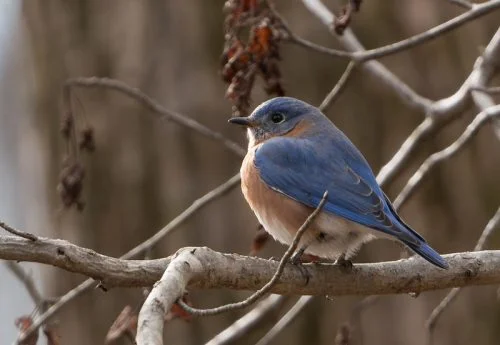
The eastern bluebird is one of the blue-headed birds; its plumage is a rich blue, white, and rusty red. It’s a little migratory bird that can be found in the open woods, fields, and orchards of North America.
The male bluebird’s head, back, and wings are all brilliant blue. They have a reddish-red coloration on their breasts. The female is the lighter of the two sexes, with a lighter gray on her head and back and hints of blue on her wings and tail.
About two-thirds of an adult bluebird’s diet consists of insects and other invertebrates. The remaining balance is made up of berries and other forms of wild produce. Grasshoppers, crickets, katydids, and beetles are its favorite prey, but it will also eat earthworms and snails.
Eastern bluebirds are most common from March to August in areas with a mix of shrubs, huge trees, meadows, and abandoned fields.
To learn more about the Eastern Bluebird you can visit: https://www.audubon.org/field-guide/bird/eastern-bluebird
3. White-throated Magpie-jay
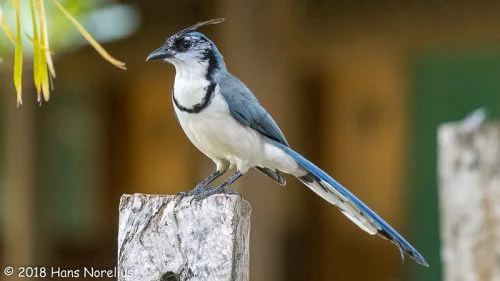
The white-throated magpie-jay is a sizable magpie-jay species found in Central America. From Jalisco, Mexico, to Guanacaste, Costa Rica, it inhabits the Pacific-slope thorn forest. Magpie-jays are raucous, sociable birds that frequently move in easy-to-find swarms and swarm their viewers.
The species has a notably long tail and a feather crest on its head that is somewhat curled. The crest of the other two subspecies is white or blue, whereas the crest of the nominate race is black.
White-throated magpie-jays are omnivorous, eating both plant and animal matter. Invertebrates like insects and caterpillars, frogs, lizards, eggs and nestlings of other birds, seeds, and fruits are all part of the diet.
It rarely occurs in columnar cactus forests, but it is widespread in deciduous woodland, thorn forests, gallery forests, forest borders, and cultivated areas like coffee plantations. Even though males leave their native areas a few years after they leave the nest, this species does not migrate.
4. Indigo Bunting
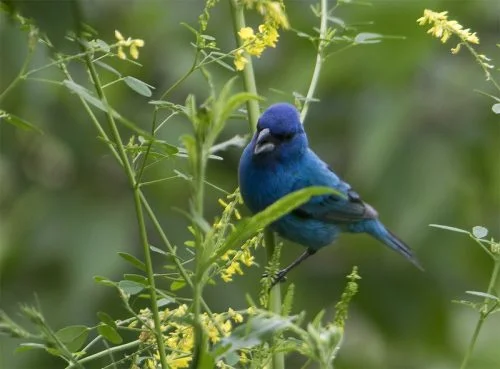
The Indigo Bunting, a member of the cardinal family, is a little bird found only in the Americas. During mating season, the adult male takes on a brilliant cerulean blue hue. The body is black and white, while the head is blue. Black with blue borders characterizes the wings and tail.
During the breeding season, they feed on insects like caterpillars, grasshoppers, spiders, beetles, and grass seeds, as well as seeds and berries. During the colder months, their diet consists primarily of grass seeds, with some bud and insect consumption.
Indigo buntings can be seen frequently throughout eastern North America. The summer and the spring migration are the best times to see them. Additionally, you can find them in the southwest. They spend the winter in places like the southern tip of Florida, the Caribbean, Mexico, and Central America.
Indigo buntings, like many other songbirds, move at night and use the stars to find their way.
To learn more about the Indigo Bunting you can visit: https://www.audubon.org/field-guide/bird/indigo-bunting
5. Yellow-throated Euphonia
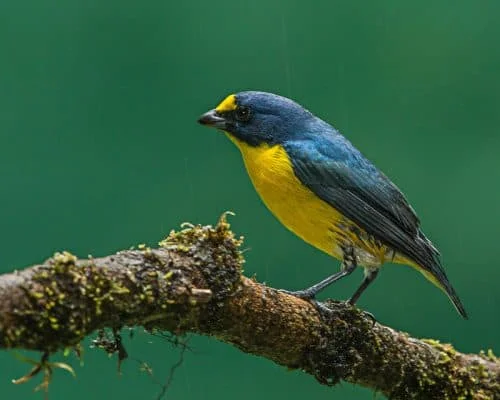
The yellow-throated euphonia is a species of songbird in the family Fringillidae. A little bird with pointed wings, a short blue beak, and a short tail.The females of this species have olive-green upperparts and whitish-gray breasts and lower parts, while the males have dark, glossy blue-black upperparts with the exception of a yellow forecrown and brilliant yellow underparts.
They mostly eat berries and fruits, especially mistletoe berries. They have a history of consuming berries that are toxic to other species. They also harvest little insects from the vegetation.
It ranges from Belize in the south to Panama in the west. It can also be found in the southeast of Mexico and all over Central America. It can be found in gallery woods, rural gardens, second growths, and arable land, in addition to moist and dry tropical forests. They may be found from sea level to 1.200 m above sea level.
6. California Scrub-Jay
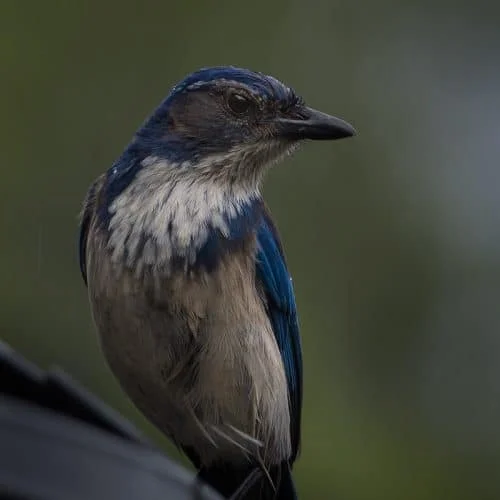
The California Scrub-Jay has earned its spot on this list with its distinctive blue wings. It has a length of 27–31 cm (including its tail) and a wingspan of 39 cm, making it a medium-sized bird.
During the warmer months of the year, the California scrub jay subsists primarily on insects and fruit. In the fall and winter, they eat primarily nuts and seeds, especially acorns. On top of that, they hunt smaller creatures like lizards and baby birds.
You can find them in the oak scrub, oak forests, and oak shrubland of the Central Valley of California. They are also found in the mangrove forests near the tip of the Baja California peninsula in Mexico, as well as in the dense, shrub-choked chaparral and coastal sage that line coastal hillsides.
The California Scrub-Jay prefers sunflower seeds and peanuts from bird feeders. If there are dense bushes or small trees in your yard, a couple may decide to build a nest there.
To learn more about the California Scrub-Jay you can visit: https://www.audubon.org/field-guide/bird/california-scrub-jay
7. Blue-gray Gnatcatcher
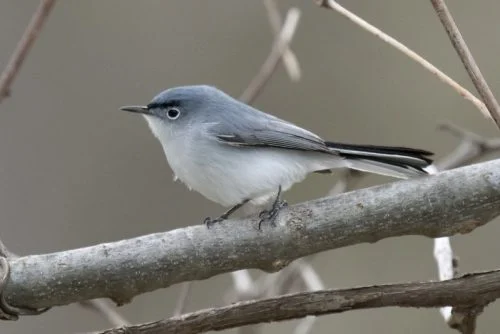
The Blue-gray Gnatcatcher is a small, long-tailed bird that inhabits broadleaf woods and scrublands. It can be identified by its persistent, mellow cries and constant movement. Adult males have white underparts, a slender dark bill, and long, black tails with white edges in addition to their blue-gray upperparts. Less blue females are contrasted with greenish-gray youngsters. A white eye ring is seen in both sexes.
The major prey items for these birds are insects, insect eggs, and spiders, so they prefer humid environments with big leaves, forests, and more open, sandy areas with few trees.
The Blue-grey Gnatcatcher breeds throughout North America, from southern Canada to Guatemala and Cuba. It spends the winter in Central and South America, beginning in southern South Carolina and traveling up the Atlantic coast as far as southern Mississippi and Texas. The oldest Blue-Gray Gnatcatcher ever recorded was a male who was at least 4 years, 2 months old when it was recaptured and released at a banding site in Pennsylvania
To learn more about the Blue-headed Vireo you can visit: https://www.audubon.org/field-guide/bird/blue-headed-vireo
8. Tree Swallow
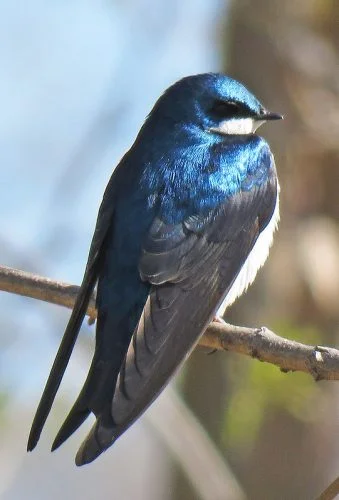
The Tree Swallow, a beautiful and impressive bird, is a harbinger of spring in much of North America.
Their upper bodies are blue-green, while their bellies are white. Female backs can be as dull greenish brown as male backs or almost as lustrous.Young ones are dull and grayish brown, without any iridescence. Compared to the Violet-green Swallow, the Tree Swallow has less white on its body.
Despite having a diverse diet, swallows are categorized as insectivores. They will spend hours flying around and catching insects when they have young to feed in the nest. Its primary food source is insects, but it also consumes berries, mollusks, and spiders.
The tree swallow breeds in both Canada and the United States. It spends the winter months in the West Indies, the southern coast of the United States, further south down the Gulf Coast into Panama, and along the northern coast of South America.
To learn more about the Tree Swallow you can visit: https://www.audubon.org/field-guide/bird/tree-swallow
9. Steller’s Jay
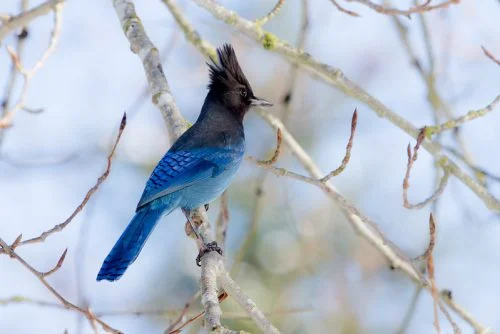
With its deep blue and black coloring and long, shaggy crest, the Steller’s Jay is an eye-catching bird. Its body is deep blue in the back and black in the front. The black covers the middle of its back and its breast.
Their nests, which are constructed 6–30 feet up in evergreen trees, are built of a collection of tiny sticks that are mud-glued together and lined with fine rootlets. Their nests could be anywhere from within touching distance of a human adult to as high as three stories in the air.
Omnivores, Steller’s Jays consume roughly two-thirds vegetable matter and one-third animal matter in their diets. They consume seeds, nuts, berries, and fruits as vegetables, and invertebrates, bird eggs, and nestlings make up the animal-matter portion of their diet.
The Steller’s jay has spread from its original range in southern Alaska to northern Nicaragua and is now the dominant species of jay across the forested regions of western North America east of the Rocky Mountains.
To learn more about the Steller’s Jay you can visit: https://www.audubon.org/field-guide/bird/stellers-jay
10. Black-throated Blue Warbler
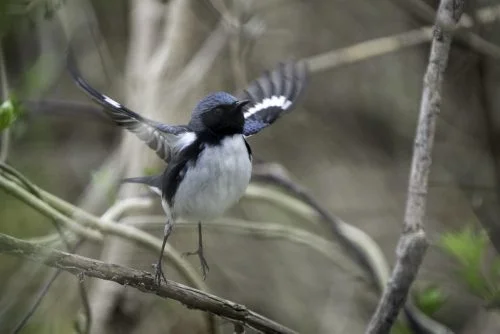
Named after the Latin term for “turning blue,” the Black-throated Blue Warbler gets its name from caerulescens.
True to its name, the male has a deep blue back, a white belly, blue wings, and a black face, neck, and sides. Olive-brown on top and brilliant yellow below best describe the mature female. At first glance, you might think that male and female Black-throated Blue Warblers are from different species.
While insects make up the majority of the black-throated blue warbler’s diet, the bird also eats fruit during the colder months. Insects, including beetles, caterpillars, butterflies, moths, flies, bugs, and spiders, make up the bulk of their diet.
In the summer breeding season, black-throated blue warblers can be found in the northern part of North America. They can be spotted from the eastern shores of the Great Lakes all the way to the marine regions of Canada. During the winter season, you can find them along the coasts of the Yucatan Peninsula and southern Florida.
To learn more about the Black-throated Blue Warbler you can visit: https://www.audubon.org/field-guide/bird/black-throated-blue-warbler
11. Blue Jay
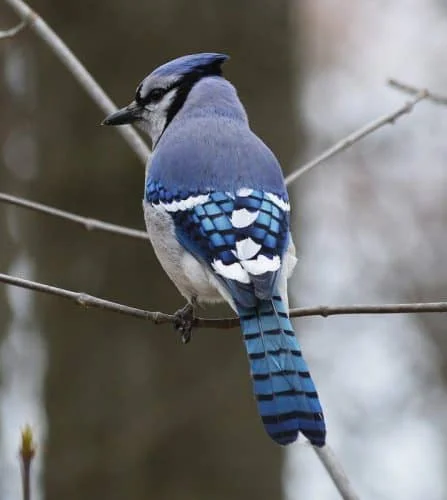
One of the most noticeable birds in eastern backyards and forests, the Blue Jay stands out with its loud calls and vivid plumage. Its upper body is blue, while the lower half is white, and the crest is blue. Its neck is black and shaped like a U, and the area behind the crest is also black.
Blue Jays eat a diverse range of foods, including insects, nuts, seeds, and grains found in trees, bushes, and on the ground. In addition, they take small vertebrates that have died or been wounded.
Even though the average lifespan of a Blue Jay is between 5 and 7 years, the longest Blue Jay on record lived for at least 26 years and 11 months.
The majority of eastern North America is home to this bird all year. The borders of woodlands are where you’ll find the greatest concentration of these animals. Cities and suburbs with oak trees or bird feeders often have these critters.
To learn more about the Blue Jay you can visit: https://www.audubon.org/field-guide/bird/blue-jay
12. Mountain Blue Bird
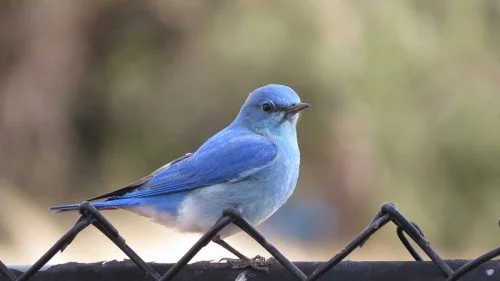
The mountain bluebird is a species of thrush that is found in the hilly regions of western North America. It is a migratory bird.
The male Mountain Bluebird is easily identified by its unique blue plumage that lightens at the base, darkens on the wings and tail, and is mostly blue overall. A white stripe can be seen at the end of their tail as well. Females tend to have a blue tinge to their wings and tails to complement their general brown coloration. In rare instances, an orange-brown effusion has been observed on the breast.
As its name suggests, this bird eats everything. It eats spiders, grasshoppers, flies, and other small insects.
They prefer the higher elevations of western North America, especially Alaska, for breeding. They spend the winter in Mexico and the summer in western Canada and Alaska, but they only live in a handful of states year-round.
13. Western Bluebird
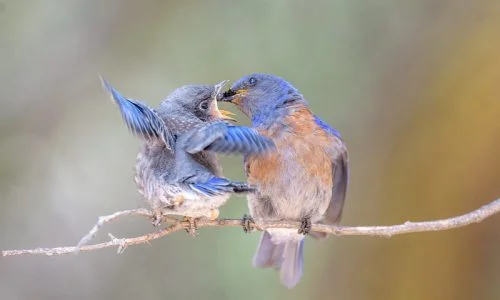
Approximately 15–18 centimeters in length, the Western Bluebird belongs to the thrush family. A male adult’s upper parts and throat are a brilliant blue, while the rest of his body is orange, his back has a brownish patch, and his belly and undertail coverts are gray. The female adult has a grayer neck and breast than the male, a less vibrant orange chest, and a grayer belly and undertail coverts.
Western Bluebirds eat mostly insects and glean them from the ground, while they also do some foraging from perches. Nestling bluebirds likely rely heavily on grasshoppers and beetles for nutrition.
It is found throughout the year. The year-round range goes from the northern coast of California to the southern states of Oaxaca and Veracruz in Mexico, as well as the southern Rocky Mountains and the state of Arizona in the United States.You can see Western Bluebirds by looking for them perched low in wooded areas or along forest margins. Also, keep an eye out for them atop nesting boxes and fence posts this summer.
